Harris C.M., Piersol A.G. Harris Shock and vibration handbook
Подождите немного. Документ загружается.

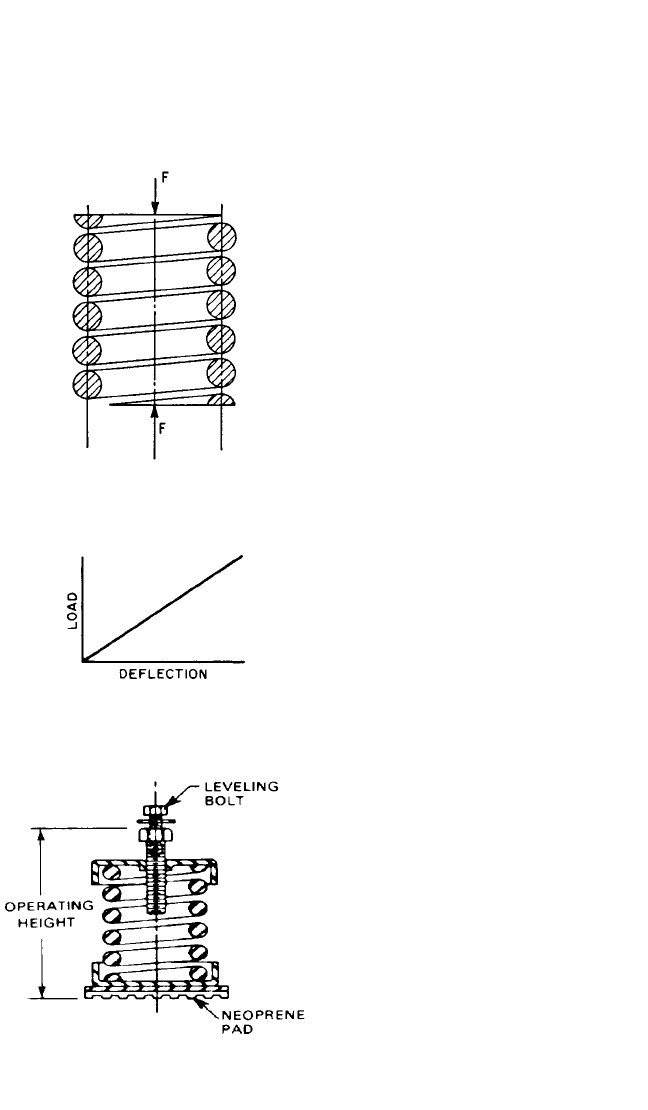
provide unusual advantages where low-frequency isolation is required; they can be
used in many of the same applications as metal springs, but without certain disadvan-
tages of the latter. Metal springs used in shock and vibration control are usually cat-
egorized as being of the following types: helical springs (coil springs), ring springs,
Belleville (conical or conical-disc) springs, involute (volute) springs, leaf and can-
tilever springs, and wire-mesh springs.
Helical Springs (Coil Springs). Heli-
cal springs (also known as coil springs)
are made of bar stock or wire coiled into
a helical form, as illustrated in Fig. 32.3.
The load is applied along the axis of
the helix. In a compression spring the
helix is compressed; in a tension spring it
is extended. The helical spring has a
straight load-deflection curve, as shown
in Fig. 32.4. This is the simplest and most
widely used energy-storage spring. En-
ergy stored by the spring is represented
by the area under the load-deflection
curve.
Helical springs have the inherent
advantages of low cost, compactness,
and efficient use of material. Springs of
this type which have a low natural fre-
quency when fully loaded are available.
For example, such springs having a nat-
ural frequency as low as 2 Hz are rela-
tively common. However, the static
deflection of such a spring is about 2.4
in. (61 mm). For such a large static
deflection, the spring must have ade-
quate lateral stability or the mounted
equipment will tip to one side. There-
fore, all forces on the spring must be
along the axis of the spring. For a given
natural frequency, the degree of lateral
stability depends on the ratio of coil
diameter to working height. Lateral sta-
bility also may be achieved by the use of
a housing around the spring which re-
stricts its lateral motion. Helical springs
provide little damping, which results
in transmissibility at resonance of 100
or higher. They effectively transmit
high-frequency vibratory energy and
therefore are poor isolators for struc-
ture-borne noise paths unless they are
used in combination with an elastomer
which provides the required high-
frequency attenuation, as illustrated in
Fig. 32.5.
SHOCK AND VIBRATION ISOLATORS AND ISOLATION SYSTEMS 32.9
FIGURE 32.3 Cross section of a helical spring
showing the direction of the applied force F.
FIGURE 32.4 Load-deflection curve for a hel-
ical spring.
FIGURE 32.5 Helical spring isolator for
mounting machinery.
8434_Harris_32_b.qxd 09/20/2001 12:32 PM Page 32.9
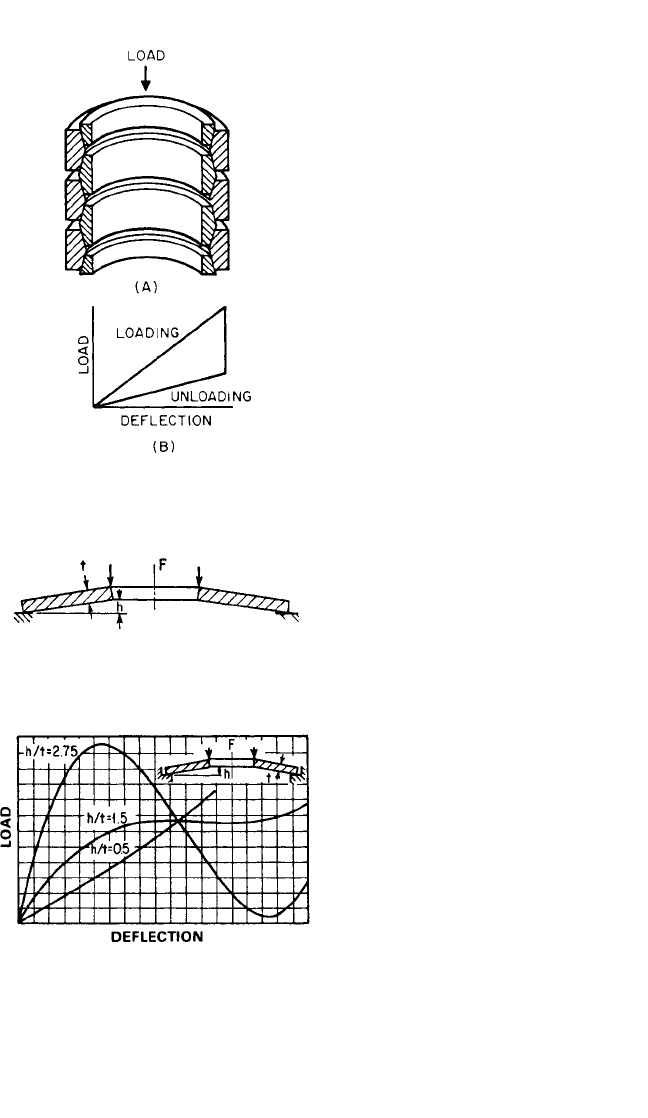
Ring Springs. A ring spring, shown in
Fig. 32.6A, absorbs the energy of motion
in a few cycles, dissipating it as a result
of friction between its sections. With a
high load capacity for its size and weight,
a ring spring absorbs linear energy with
minimum recoil. It has a linear load-
deflection characteristic, shown in Fig.
32.6B. Springs of this type often are used
for loads of from 4000 to 200,000 lb
(1814 to 90,720 kg), with deflections
between 1 in. (25 mm) and 12 in. (305
mm).
Belleville Springs. Belleville springs
(also called coned-disc springs), illus-
trated in Fig. 32.7, absorb more energy in
a given space than helical springs. Springs
of this type are excellent for large loads
and small deflections. They are available
as assemblies, arranged in stacks. Their
inherent damping characteristics are like
those of leaf springs: Oscillations quickly
stop after impact. The coned discs of this
type of spring have diametral cross sec-
tions and loading, as shown in Fig. 32.7.
The shape of the load-deflection curve
depends primarily on the ratio of the
unloaded cone (or disc) height h to the
thickness t. Some load-deflection curves
are shown in Fig. 32.8 for different values
of h/t, where the spring is supported so
that it may deflect beyond the flattened
position. For a ratio of h/t approximately
equal to 0.5, the curve approximates a
straight line up to a deflection equal to
half the thickness; for h/t equal to 1.5,
the load is constant within a few percent
over a considerable range of deflection.
Springs with ratios h/t approximating 1.5
are known as constant-load or stiffness
springs. Advantages of Belleville springs
include the small space requirement in
the direction of the applied load, the abil-
ity to carry lateral loads, and load-
deflection characteristics that may be
changed by adding or removing discs.
Disadvantages include nonuniformity of
stress distribution, particularly for large
ratios of outside to inside diameter.
Involute Springs. An involute spring, shown in Fig. 32.9A and 32.9B, can be used
to better advantage than a helical spring when the energy to be absorbed is high and
32.10 CHAPTER THIRTY-TWO
FIGURE 32.6 Ring spring. (A) Cross section.
(B) Load-deflection characteristic when it is
loaded and when it is unloaded.
FIGURE 32.7 A Belleville spring made up of
a coned disc of thickness t and height h, axially
loaded by a force F.
FIGURE 32.8 The load-deflection character-
istic for a Belleville spring having various ratios
of h/t.
8434_Harris_32_b.qxd 09/20/2001 12:32 PM Page 32.10
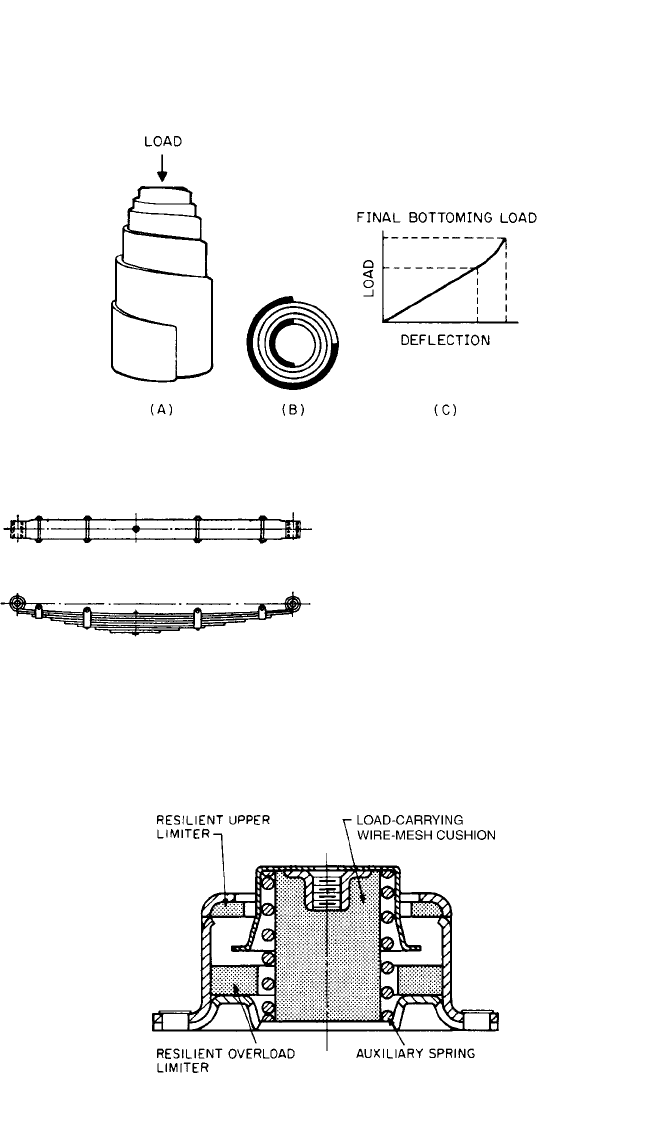
space is rather limited. Isolators of this type have a nonlinear load-deflection charac-
teristic, illustrated in Fig. 32.9C. They are usually much more complex in design than
helical springs.
SHOCK AND VIBRATION ISOLATORS AND ISOLATION SYSTEMS 32.11
FIGURE 32.11 Wire-mesh spring, shown in section.
FIGURE 32.9 An involute spring. (A) Side view. (B) Cross sec-
tion. (C) Load-deflection characteristic.
Leaf Springs. Leaf springs are some-
what less efficient in terms of energy
storage capacity per pound of metal
than helical springs. However, leaf
springs may be applied to function as
structural members. A typical semiellip-
tic leaf spring is shown in Fig. 32.10.
Wire-Mesh Springs. Knitted wire
mesh acts as a cushion with high damp-
ing characteristics and nonlinear spring constants.A circular knitting process is used
to produce a mesh of multiple, interlocking springlike loops. A wire-mesh spring,
shown in Fig. 32.11, has a multidirectional orientation of the spring loops, i.e., each
FIGURE 32.10 Semielliptic leaf spring.
8434_Harris_32_b.qxd 09/20/2001 12:32 PM Page 32.11

loop can move freely in three directions, providing a two-way stretch. Under tensile
or compressive loads, each loop behaves like a small spring; when stress is removed,
it immediately returns to its original shape. Shock loadings are limited only by the
yield strength of the mesh material used. The mesh cushions, enclosed in springs,
have characteristics similar to a spring and dashpot.
Commonly used wire mesh materials include such metals as stainless steel, galva-
nized steel, Monel, Inconel, copper, aluminum, and nickel. Wire meshes of stainless
steel can be used outside the range to which elastomers are restricted, i.e., −65 to
350°F (−53 to 177°C); furthermore, stainless steel is not affected by various environ-
mental conditions that are destructive to elastomers. Wire-mesh springs can be fab-
ricated in numerous configurations, with a broad range of natural frequency,
damping, and radial-to-axial stiffness properties. Wire-mesh isolators have a wide
load tolerance coupled with overload capacity. The nonlinear load-deflection char-
acteristics provide good performance, without excessive deflection, over a wide load
range for loads as high as four times the static load rating.
Stiffness is nonlinear and increases with load, resulting in increased stability and
gradual absorption of overloads. An isolation system has a natural frequency pro-
portional to the ratio of stiffness to mass; therefore, if the stiffness increases in pro-
portion to the increase in mass, the natural frequency remains constant. This
condition is approached by the load-deflection characteristics of mesh springs. The
advantages of such a nonlinear system are increased stability, resistance to bottom-
ing out of the mounting system under transient overload conditions, increased shock
protection, greater absorption of energy during the work cycle, and negligible drift
rate. Critical damping of 15 to 20 percent at resonance is generally considered desir-
able for a wire-mesh spring. Environmental factors such as temperature, pressure,
and humidity affect this value little, if at all. Damping varies with deflection: high
damping at resonance and low damping at higher frequencies.
AIR (PNEUMATIC) SPRINGS
A pneumatic spring employs gas as its resilient element. Since the gas is usually air,
such a spring is often called an air spring. It does not require a large static deflec-
tion; this is because the gas can be compressed to the pressure required to carry the
load while maintaining the low stiffness necessary for vibration isolation. The
energy-storage capacity of air is far greater per unit weight than that of mechanical
spring materials, such as steel and rubber. The advantage of air is somewhat less
than would be indicated by a comparison of energy-storage capacity per pound of
material because the air must be contained. However, if the load and static deflec-
tion are large, the use of air springs usually results in a large weight reduction.
Because of the efficient potential energy storage of springs of this type, their use in
a vibration-isolation system can result in a natural frequency for the system which
is almost 10 times lower than that for a system employing vibration isolators made
from steel and rubber.
An air spring consists of a sealed pressure vessel, with provision for filling and
releasing a gas, and a flexible member to allow for motion. The spring is pressurized
with a gas which supports the load. Air springs generally have lower resonance fre-
quencies and smaller overall length than mechanical springs having equivalent char-
acteristics; therefore, they are employed where low-frequency vibration isolation is
required. Air springs may require more maintenance than mechanical springs and
are subject to damage by sharp and hot objects. The temperature limits are also
restricted compared to those for mechanical springs.
32.12 CHAPTER THIRTY-TWO
8434_Harris_32_b.qxd 09/20/2001 12:32 PM Page 32.12

Figure 32.12 shows four of the most common types of air springs. The air spring
shown in Fig. 32.12A is available with one, two, and three convolutions. It has a
very low minimum height and a stroke that is greater than its minimum height.The
rolling lobe (reversible sleeve) spring shown in Fig. 32.12B has a large stroke capa-
bility and is used in applications which require large axial displacements, as, for
example, in vehicle applications. The isolators shown in Fig. 32.12A and B may
have insufficient lateral stiffness for use without additional lateral restraint. The
rolling diaphragm spring shown in Fig. 32.12C has a small stroke and is employed
to isolate low-amplitude vibration. The air spring shown in Fig. 32.12D has a low
height and a small stroke capability. The thick elastomer sidewall can be used to
cushion shock inputs.
The load F that can be supported by an air spring is the product of the gage pres-
sure P and the effective area S (i.e., F = PS). For a given area, the pressure may be
adjusted to carry any load within the strength limitation of the cylinder walls. Since
the cross section of many types of air springs may vary, it is not always easy to
determine. For example, the spring shown in Fig. 32.12A has a maximum effective
area at the minimum height of the spring and a smaller effective area at the maxi-
mum height.The spring illustrated in Fig. 32.12B is acted on by a piston which is con-
toured to vary the effective area. In vehicle applications this is often done to provide
a low spring stiffness near the center of the stroke and a higher stiffness at both ends
of the stroke in order to limit the travel.The effective areas of the springs illustrated
in Fig. 32.12C and D are usually constant throughout their stroke; the elastomeric
diaphragm of the spring shown in Fig. 32.12D adds significantly to its stiffness. Air
springs are commercially available in various sizes that can accommodate static
loads that range from as low as 25 lb (11.3 kg) to as high as 100,000 lb (45,339 kg)
with a usable temperature range of from −40 to 180°F (−40 to 83°C). System natural
frequencies as low as 1 Hz can be achieved with air springs.
SHOCK AND VIBRATION ISOLATORS AND ISOLATION SYSTEMS 32.13
FIGURE 32.12 Four common types of air springs. (A) Air spring with convolutions. (B) A
rolling lobe air spring. (C) Rolling diaphragm air spring. (D) Air spring having a diaphragm
and an elastomeric sidewall.
8434_Harris_32_b.qxd 09/20/2001 12:32 PM Page 32.13
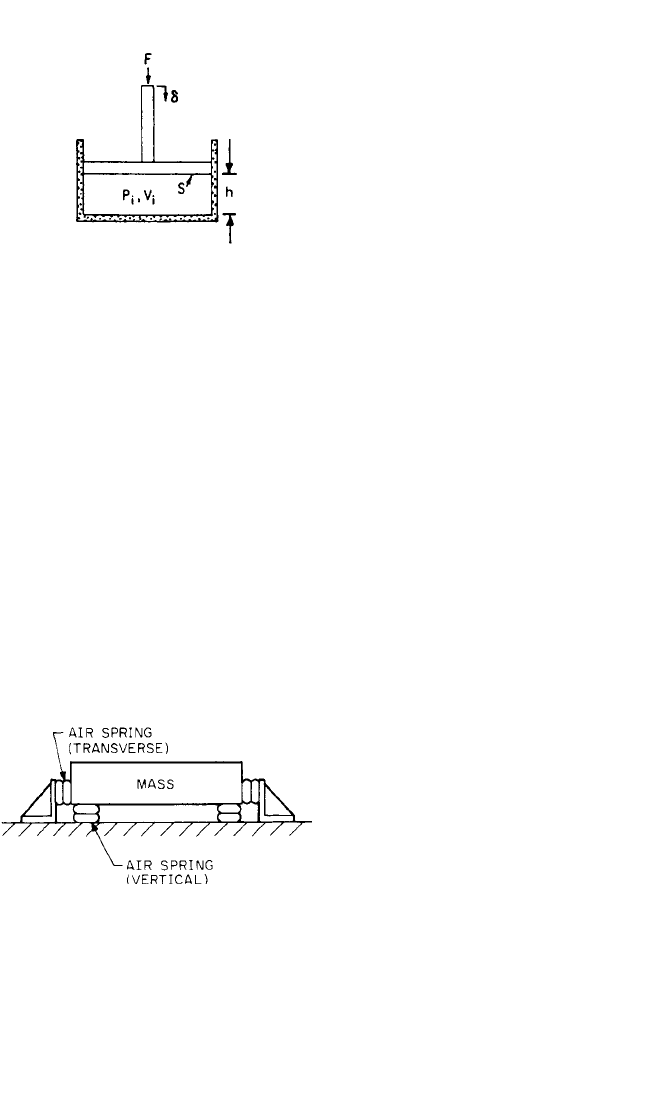
Stiffness. The stiffness of the air
spring of Fig. 32.13 is derived from the
gas laws governing the pressure and vol-
ume relationship. Assuming adiabatic
compression, the equation defining the
pressure-volume relationship is
PV
n
= P
i
V
i
n
(32.1)
where P
i
= absolute gas pressure at
reference displacement
V
i
= corresponding volume of
contained gas
n = ratio of specific heats of
gas, 1.4 for air
If the area S is constant, and if the change in volume is small relative to the initial
volume V
i
[i.e., if Sδ (where δ is the dynamic deflection) << V
i
)], then the stiffness k
is given by
k = (32.2)
Transverse Stiffness. The transverse stiffness (i.e., the stiffness to laterally
applied forces) of the air springs illustrated in Fig. 32.12A and B varies from very
small to moderate; the natural frequencies for such springs vary from 0 to 3 Hz. The
spring illustrated in Fig. 32.12C has a higher transverse stiffness, with natural fre-
quencies ranging from 2 to 8 Hz. The spring illustrated in Fig. 32.12D has a moder-
ate transverse stiffness; the natural frequency varies in the range from 3 to 5 Hz. If
an installation requires the selection of an air spring having insufficient transverse
stiffness, additional springs in the transverse direction are often employed for stabil-
ity, as shown in Fig. 32.14.
At frequencies above 3 Hz, the compression of gases used in air springs tends to
be adiabatic and the ratio of specific heats n for both air and nitrogen has a value of
1.4.At frequencies below approximately
3 Hz, the compression tends to be
isothermal and the ratio of specific heats
n has a value of 1.0, unless the spring is
thermally insulated. For thermally insu-
lated springs, the transition from adia-
batic to isothermal occurs at a frequency
of less than 3 Hz. Gases other than air
which are compatible with the air spring
materials can also be used. For example,
sulfur hexafluoride (SF
6
) has a value of
n equal to 1.09—a value that reduces the
axial spring stiffness by 22 percent; it
also has a considerably lower perme-
ation (leakage through the air spring
material) rate than air, which may reduce the frequency of recharging (repressuriz-
ing) for a closed (passive) air spring.
Damping. Air springs have some inherent damping that is developed by damping
in the flexible diaphragm or sidewall, friction, damping of the gas, and nonlinearity.
nP
i
S
2
V
i
32.14 CHAPTER THIRTY-TWO
FIGURE 32.13 Illustration of a single-acting
air spring consisting of a piston and a cylinder.
FIGURE 32.14 An air spring used to support a
load and provide vibration isolation in the verti-
cal direction. In addition, air springs are pro-
vided on the sides to increase the transverse
stiffness.
8434_Harris_32_b.qxd 09/20/2001 12:32 PM Page 32.14

The damping varies with the vibration amplitude; however, it generally is between 1
and 5 percent of critical damping.
Natural Frequency. In U.S. Customary units, the natural frequency f
n
of an
undamped air spring is expressed by
f
n
= 3.13
1/2
=δ
1
−1/2
(32.3a)
where W = supported weight, lb
k
1
= stiffness of the air spring, lb/in.
δ
1
= static deflection, in.
In S.I. units, the natural frequency is given by
f
n
=δ
2
−1/2
(32.3b)
where δ
2
= static deflection, cm
ISOLATORS IN COMBINATION
When a number of isolators are used in a system, they are usually combined either
in parallel or in series or in some combination thereof.
ISOLATORS IN PARALLEL
Most commonly, isolators are arranged in parallel. Figure 32.15 depicts three isola-
tors schematically as springs in parallel. A number of vibration isolators are said to
be in parallel if the static load supported is divided among them so that each isola-
tor supports a portion of the load. If the stiffness of each of the n isolators in Fig.
32.15 is represented by k, the stiffness of the combination is given by
Stiffness of n isolators in parallel = nk (32.4)
k
1
W
SHOCK AND VIBRATION ISOLATORS AND ISOLATION SYSTEMS 32.15
FIGURE 32.15 Schematic diagram of three
springs in parallel. Individual spring loads are added
to obtain the total weight. With the static load equal
on all springs, the static deflection of each spring is
the same.
8434_Harris_32_b.qxd 09/20/2001 12:32 PM Page 32.15

Since in Fig. 32.15 isolator spacing is symmetrical in relation to the center-of-gravity
and the same isolator is used at all support points, the stiffness of the combination is
3 times the stiffness of a single isolator, and the static deflection is the same at each
isolator.
ISOLATORS IN SERIES
When three isolators are combined in
series, as shown in Fig. 32.16, the static
load is transmitted from one isolator to
the next. If the static weight is supported
by n isolators in series, each having the
stiffness k, the stiffness of the combina-
tion is given by
Stiffness of n isolators in series
=
(32.5)
Thus, if the mass is supported by three
identical isolators (Fig. 32.16), the stiff-
ness of this combination is one-third the
stiffness of a single isolator, and the static
deflection is the sum of the deflection of
the individual isolators (or 3 times the
static deflection of a single isolator).
ISOLATOR SELECTION
IMPORTANT FACTORS AFFECTING SELECTION
Stiffness and damping are the basic properties of an isolator which determine its use
in a system designed to provide vibration isolation and/or shock isolation. These
properties usually are found in isolator supplier literature. However, the following
other important factors must be considered in the selection of an isolator:
Type and Direction of Disturbance. The source of a dynamic disturbance (shock
or vibration) influences the selection of an isolator in several ways. For example, a
decision can be made whether to isolate the source of the disturbance or to isolate
the item being disturbed. This decision affects which isolator is to be used. Consider
the operation of a heavy punch press which has an adverse effect on a nearby elec-
tronic instrument. Isolation of the punch press would reduce this effect but would
require fairly large isolators which might have to be resistant to grease or oil. In con-
trast, isolation of the instrument would also provide the required protection, but the
required isolators would be smaller and (since grease or oil would not be a consid-
eration) could be fabricated of a preferred elastomer.
A knowledge of the source of the vibration can aid in defining the problem to be
solved.Within a given industry there may be published material describing problems
similar to the one under consideration. Such material may describe possible solu-
tions plus equipment fragility, and/or dynamic characteristics of the equipment.
k
n
32.16 CHAPTER THIRTY-TWO
FIGURE 32.16 Schematic diagram of three
springs in series. Individual spring deflections
are added to obtain total deflection, but each
spring carries the total load.
8434_Harris_32_b.qxd 09/20/2001 12:32 PM Page 32.16

Type of Disturbance. The dynamic environment can be delineated into three
categories: (1) periodic vibration—sinusoidal continuos motion or acceleration
occurring at discrete frequencies, (2) random vibration—the simultaneous existence
of any and all frequencies and amplitudes in any and all phase relationships as exem-
plified by noise, and (3) transient phenomenon (shock)—a nonperiodic sudden
change of velocity, acceleration, or displacement. Usually some combination of these
three categories occurs in most isolation systems. A knowledge of the dynamic dis-
turbance is very important in the choice of an isolator. For example, in the case of an
instrument supported by isolators, the resilient mounts permit the supported body
to “stand still” by virtue of its own inertia while the support structure generates peri-
odic or random vibration. In contrast, shock attenuation involves the storage by the
isolators of the dynamic energy which impacts on the support structure and the sub-
sequent release of the energy over a longer period of time at the natural frequency
of the system. If only a vibration disturbance is present, a small isolator normally is
suitable since vibration amplitudes usually are small relative to shock amplitudes. If
a shock disturbance is the primary problem, then a larger isolator with more inter-
nal space for motion is required.
In selecting an isolator, ensure (1) that there is enough deflection capability in
the isolator to accommodate the maximum expected motions from the dynamic
environment, (2) that the load-carrying capacity of the isolator will not be exceeded;
the maximum loads due to vibration and/or shock should be calculated and checked
against the rated maximum dynamic load capacity of the isolator, and (3) that there
will be no problem as a result of overheating of the isolator or fatigue deterioration
due to long-term high-amplitude loading.
Direction of Disturbance. A factor that must be considered in the selection of
an isolator is that of the directions (axes) of the disturbance. If the vibration or shock
input occurs only in one direction, usually a simple isolator can be selected; its char-
acteristics need be specified along only one axis. In contrast, if the vibration or shock
is expected to occur along more than one axis, then the selected isolator must pro-
vide isolation (and its characteristics must be specified) along all the critical axes.
For example, consider an industrial machine which produces troublesome vibration
in the vertical direction and which must be isolated from its supporting structure. In
this case, a standard plate-type isolator may be used.This type isolator is stiffer in the
horizontal direction than in the vertical direction, which is the axis of the primary
disturbance; the horizontal stiffness does not significantly affect the motion of the
isolator in the vertical direction. Such horizontal stiffness adds to the lateral stability
of the installation.
Allowable Response of a System to the Disturbance. The allowable response
of a system is defined as the maximum allowable transmitted shock or vibration and
the maximum displacements due to such disturbances. The allowable response of a
system can be expressed in any of the following ways:
●
Maximum acceleration loading due to a shock input
●
Specific system natural frequency and maximum transmissibility at that frequency
●
Maximum acceleration, velocity, or displacement allowable over a broad fre-
quency range
●
The allowable level of vibration at some critical frequency or frequencies
●
Maximum displacement due to shock loading
The maximum acceleration which a piece of equipment can withstand without
damage or malfunction is often called fragility. The definition of some allowable
SHOCK AND VIBRATION ISOLATORS AND ISOLATION SYSTEMS 32.17
8434_Harris_32_b.qxd 09/20/2001 12:32 PM Page 32.17
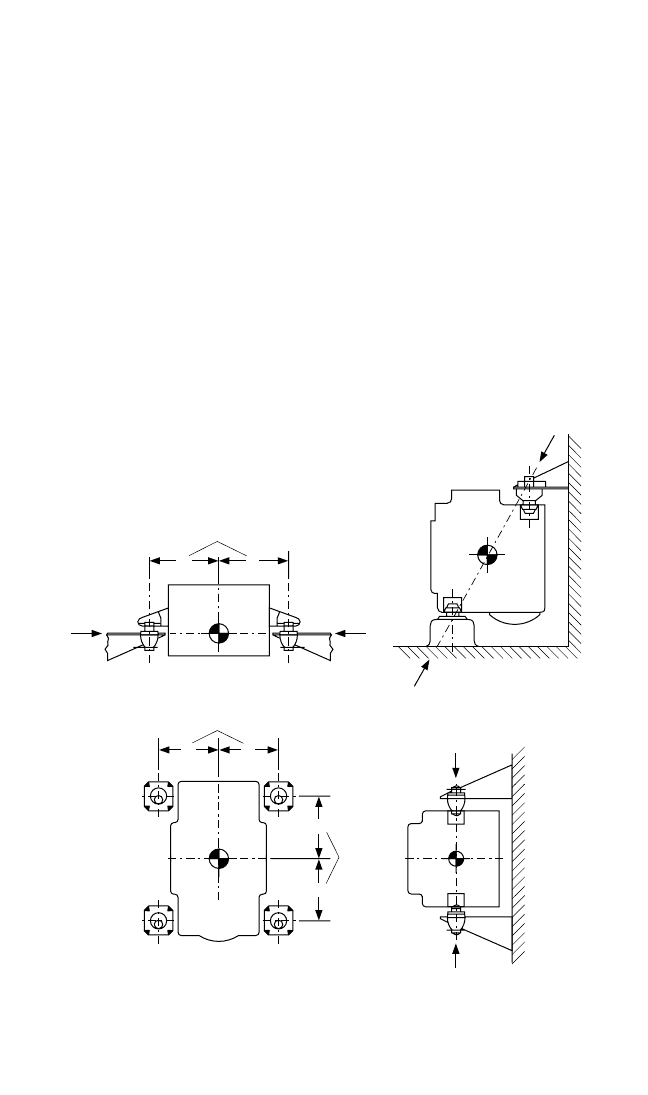
response is necessary for an appropriate isolator selection. If fragility data are not
available for the specific equipment or installation at hand, then examples of similar
situations should be used as a starting point. Suppose an isolator were chosen only
for its load-carrying capability, with no regard for the fragility of a piece of equip-
ment in a specific frequency range. Then, the natural frequency of the system might
be incorrectly placed such that a resonance within the equipment might be excited
by the isolation system.
Space and Locations Available for Isolators. Vibration and shock isolation
should be considered as early as possible in the design of a system, and an estimate
of isolator size should be made based on isolator literature. The size of the isolator
depends on the nature and magnitude of the expected dynamic disturbances and the
load to be carried. Typical literature describes the capabilities of isolators based on
such factors.
The location of isolators is very important to the dynamics of the equipment
mounted on them. For example, a center-of-gravity installation, as shown in Fig.
32.17, allows the mounted equipment to move only in straight translational modes
(i.e., a force at the center-of-gravity does not cause rotation of the equipment). This
32.18 CHAPTER THIRTY-TWO
Equidistant
Elevation
(a)
Plan
(
c
)
Elevation
(
d
)
Elevation
(b)
CG
CG
AA
Equidistant
A A
Equidistant
B
B
CG CG
FIGURE 32.17 Center-of-gravity installations of vibration isolators: (A)
Center-of-gravity horizontal support. (B) Center-of-gravity diagonal support.
(C) Symmetrical spacing about the center-of-gravity. (D) Center-of-gravity ver-
tical support. (After Davey and Payne.
2
)
8434_Harris_32_b.qxd 09/20/2001 12:32 PM Page 32.18
